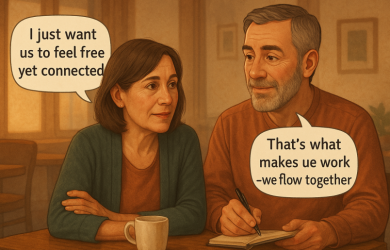ESTP Personality: Meaning, Compatibility & Dating Tips

Unlock Daily 30-Sec Tips for a Happier Relationship
👉 Subscribe FREEKey Takeaways
Marriage.com AI Quick Summary
They’re bold, spontaneous, and full of spark—the kind of people who say “yes” before the question is even finished! With a natural charm and an adventurous streak, life with someone like this is never dull… just ask their friends (or past dates).
Whether they’re planning last-minute road trips or turning simple moments into laughter-filled memories, the ESTP personality brings energy wherever they go. But behind that confident grin lies someone who sometimes struggles to sit still, open up, or slow down for long talks.
Still, there’s more depth there than meets the eye; you just have to know where to look.
What is an ESTP personality type?
The ESTP personality type—short for Extraverted, Sensing, Thinking, Perceiving—is known for being energetic, action-oriented, and grounded in the present moment. These individuals are often spontaneous, practical, and confident, thriving in dynamic environments where quick thinking and adaptability are essential.
A research paper published in 2023 states that ESTPs are energetic, practical, and thrive on real-world experiences; they prefer action over theory and are highly adaptable in social situations.
For example: Someone who thrives in fast-paced situations—like a firefighter or a startup entrepreneur—making snap decisions under pressure while keeping everyone energized. That’s a classic ESTP in action.
Please note
If you relate to the ESTP personality type but sometimes feel misunderstood or too “impulsive,” don’t worry. There’s strength in your instincts, and growth comes with self-awareness—not changing who you are.
5 characteristics of an ESTP
ESTPs are often described as vibrant, bold, and hands-on people who enjoy living in the here and now. If you’ve ever met someone who jumps into action without overthinking and keeps the mood light even in serious situations, chances are—they were an ESTP.
Below are some defining traits that truly capture the essence of the ESTP personality.
1. They’re highly action-oriented
ESTPs prefer doing over thinking. They feel most alive when they’re on the move, whether it’s solving a real-world problem, trying something new, or leading a group project. Long lectures or overly detailed plans can bore them—what they need is something they can dive into.
They’re the type to say, “Let’s just try it and see what happens,” because they learn best by experience. You can count on an ESTP to take initiative when others hesitate.
- Example: An ESTP might fix a broken bike without looking up a tutorial, just using trial and error.
2. They thrive in social environments
ESTPs are natural people-persons. They’re lively, charming, and often the first to break the ice in a new group. They pick up on social cues quickly, which makes them persuasive and fun to be around.
They enjoy attention but also know how to use it to make others feel at ease. If you want someone who can connect instantly with strangers, an ESTP personality type fits the bill.
- Example: An ESTP at a party might chat up someone standing alone and instantly have them laughing.
3. They think fast and respond even faster
Speed is a strength for ESTPs—in thought, in speech, and in action. They’re quick problem-solvers who rely on logic and practical thinking rather than emotional analysis.
While this makes them excellent in emergencies or business decisions, it also means they sometimes overlook how others feel. Still, in fast-moving situations, few can match their clarity.
- Example: During a work crisis, an ESTP might organize a last-minute plan that saves the day without breaking a sweat.
4. They live in the moment
Being present comes naturally to ESTPs. They enjoy physical experiences, sensory pleasures, and anything that stimulates the now.
A research paper published in ResearchGate states that being present in the moment through mindfulness helps lower stress, increases positive feelings, and makes people view their experiences as more meaningful and important.
Planning too far ahead or sitting still to reflect isn’t really their thing—they prefer what’s real and happening right in front of them. This trait gives them a zest for life but can sometimes lead to impulsivity.
- Example: An ESTP might book a spontaneous weekend trip just because the weather’s perfect.
5. They’re confident risk-takers
The ESTP personality is known for embracing challenges without second-guessing. Whether it’s a business idea, a bold fashion choice, or asking someone out, they usually act with confidence.
Their calculated risk-taking often leads to success, though sometimes they may leap before they look. Even then, they tend to land on their feet.
- Example: An ESTP might invest in a new venture after one strong conversation, trusting their gut and moving quickly.
Which personality types are most compatible with an ESTP?
ESTPs bring energy, excitement, and spontaneity to relationships, which means their ideal partners are often those who can balance that bold spirit with emotional depth, patience, or shared zest for life. Compatibility isn’t just about similarities—it’s often about finding someone who complements your natural rhythm.
So when we talk about what is ESTP chemistry in love, it often involves a mix of adventure, balance, and mutual respect. Below are the personality types that tend to mesh best with the ESTP personality.
1. ISFJ – Introverted, Observant, Feeling, and Judging traits
ISFJs are grounded, nurturing, and deeply loyal—an ideal counterbalance to the spontaneous, thrill-loving ESTP. While ESTPs focus on the present and move quickly, ISFJs tend to think carefully and prioritize emotional safety.
This creates a dynamic where both partners can learn from each other: ESTPs bring excitement into the ISFJ’s world, while ISFJs offer calm and emotional grounding.
- Why it works: Opposites attract here. ISFJs admire the ESTP’s boldness, and ESTPs value the ISFJ’s steadiness and heart.
2. INFJ – Introverted, Intuitive, Feeling, and Judging
INFJs are deep thinkers who seek meaningful connections. They may seem reserved at first, but their emotional depth can be magnetic for the outward, action-driven ESTP. This pairing brings together two very different communication styles—but when it works, the result is emotional growth and real connection.
- Why it works: INFJs bring introspection and emotional insight; ESTPs bring lightness and courage. Together, they balance fun with meaning.
3. ESFP – Extroverted, Sensing, Feeling, and Perceiving
ESFPs and ESTPs both love living in the moment, making this duo high-energy and full of fun. They’re both spontaneous, outgoing, and love to experience life hands-on. While they may need to watch out for avoiding deeper conversations, their mutual excitement keeps the spark alive.
- Why it works: They “get” each other’s need for adventure and connection without needing to slow down too much.
4. ISTJ – Introverted, Sensing, Thinking, and Judging
ISTJs are dependable and grounded—exactly the kind of stability that can help balance the ESTP personality type. While they’re more reserved than ESTPs, they offer a sense of order and long-term planning that ESTPs sometimes lack. Together, they can create a partnership that is both exciting and reliable.
- Why it works: ESTPs add spontaneity to the ISTJ’s routine, while ISTJs offer long-term structure to the ESTP’s spontaneous world.
7 dating tips for ESTP
Dating as an ESTP can be exciting, spontaneous, and full of life—just like you. But sometimes, your need for action and quick decisions might make it hard to slow down and connect on a deeper level.
That doesn’t mean you’re doing anything wrong—it just means there’s room to grow and enjoy love more meaningfully. Whether you’re newly dating or in a committed relationship, these tips will help you make the most of your strengths while supporting emotional connection.
1. Slow down and really listen
As an ESTP, you’re quick to jump in and respond, but relationships thrive when both people feel heard. Slowing down helps you understand your partner’s feelings—not just their words. Sometimes, listening without fixing is the most loving thing you can do. It also helps your partner feel safe opening up again.
- How to do it: Pause before replying; focus on their tone and expressions, not just the facts.
2. Don’t skip the emotional stuff
The ESTP personality naturally leans toward facts, logic, and real-time action. But love often lives in the emotional and vulnerable zones.
A research paper titled Vulnerability in Intimate Relationships states that showing vulnerability helps build closeness and trust between partners, even though it may feel risky or uncomfortable in emotionally intimate moments.
While it may feel uncomfortable, showing feelings builds intimacy and trust. It’s okay to not have all the answers—being open is powerful.
- How to do it: Share how something made you feel instead of just what happened.
3. Give space for routine and stability
You love change, excitement, and trying new things—but not everyone thrives that way. Some partners crave routines or need more predictability. Instead of seeing structure as boring, think of it as a steady rhythm that supports your relationship. It’s how many people feel emotionally secure.
- How to do it: Set a regular date night or check-in—even if spontaneous plans are more your style.
4. Learn to be present emotionally, not just physically
You’re great at being there in person, making eye contact, and sharing laughs—but being emotionally present is a deeper form of connection. Emotional presence means staying engaged even when the conversation is hard or less exciting. It’s one of the most meaningful gifts you can offer.
- How to do it: When your partner shares something heavy, resist the urge to change the subject—just stay with them in it.
5. Be honest about your needs
As someone with the ESTP personality type, you’re likely independent and straightforward. Don’t downplay your need for space, adventure, or stimulation—just express it respectfully. Open communication about what energizes you prevents resentment and helps you both adjust expectations.
- How to do it: Say things like, “I recharge by doing X—can we talk about how that fits into our time together?”
6. Show your care through actions
Words can mean a lot, but for you, love often looks like doing. That’s okay! Acts of service, planning fun dates, or solving problems for your partner are your way of showing affection. Just make sure your efforts match what your partner actually needs.
- How to do it: Ask them, “What helps you feel cared for?”—then take action based on their answer.
Watch this TED Talk by Joanne Davila, clinical psychologist, who shares practical skills for building stronger, healthier, and more satisfying romantic relationships.
7. Reflect on long-term goals together
ESTPs are fantastic in the now—but relationships also need a little vision. Taking time to think ahead shows maturity and investment. Even if planning isn’t your favorite thing, doing it together can deepen your connection and avoid misunderstandings down the line.
- How to do it: Have a chill conversation about future hopes over coffee or on a walk—nothing too serious, just curious.
FAQ
Understanding the ESTP personality can be both fun and eye-opening—especially when you’re trying to figure out how they think, love, and respond to life. These quick answers clear up some common curiosities about the ESTP personality type, whether you’re one yourself or just trying to understand someone better.
-
What is ESTP behavior like in relationships?
ESTPs are playful, spontaneous, and affectionate partners who enjoy hands-on experiences and fun. They may struggle with emotional depth at times, but they’re loyal and fully present when engaged.
-
Do ESTPs fall in love easily?
Yes, ESTPs can fall fast—especially when there’s excitement and chemistry. But staying in love requires emotional connection, which they develop more deeply over time.
-
Are ESTPs good long-term partners?
Absolutely. While commitment may not come instantly, a mature ESTP personality brings energy, loyalty, and problem-solving skills to the relationship—especially when they feel respected and free to be themselves.
Ending note
The ESTP personality type is bold, hands-on, and full of life—someone who brings energy and movement wherever they go. While relationships can sometimes challenge their need for freedom or emotional vulnerability, ESTPs are more than capable of deep, lasting love when they feel understood and accepted.
With a little balance—between action and reflection, excitement and stability—their connections can thrive in ways that feel both meaningful and alive. Whether you’re an ESTP or loving one, remember: growth doesn’t mean changing who you are, just learning how to show up with heart, honesty, and presence.
 Tips
Tips
Write your tip or submit a video tip
All tips are reviewed before the publishing.
Share this article on
Want to have a happier, healthier marriage?
If you feel disconnected or frustrated about the state of your marriage but want to avoid separation and/or divorce, the marriage.com course meant for married couples is an excellent resource to help you overcome the most challenging aspects of being married.
Recent Articles
Related Quizzes
Unlock Daily 30-Sec Tips for a Happier, Healthier Relationship
👉 Subscribe FREE on YouTube We'd love your feedback!
We'd love your feedback!
 Expert Q&A
Expert Q&A
Ask your question related to this topic & get the support you deserve from experts.



















 Thanks for your feedback!
Thanks for your feedback!